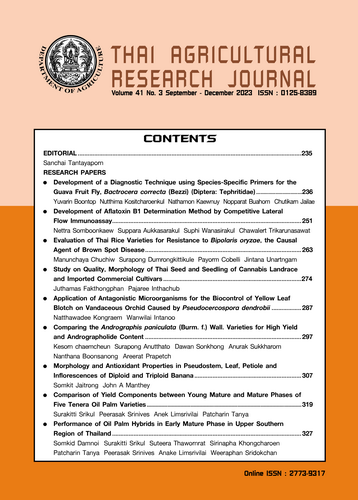Comparing the Andrographis paniculata (Burm. f.) Wall. Varieties for High Yield and Andrographolide Content
DOI:
https://doi.org/10.14456/thaidoa-agres.2023.25Keywords:
Andrographis paniculata, varietal comparison, andrographolideAbstract
Andrographis paniculata is a medicinal plant which contains an important andrographolide substance that inhibits the multiplication of COVID-19 virus. The National List of Essential Medicines prescribes andrographolide treatments for respiratory symptoms and the digestive system disorder. The current problem of A. paniculate production is the inconsistency of yield and andrographolide content that varies with genetics and environmental conditions. This research was to compare and select A. paniculata varieties that possess high productivity and andrographolide content. The experiment was conducted in 3 locations: Phichit Agricultural Research and Development Center, Uttaradit Agricultural Research and Development Center and a farmer’s farm in Bang Krathum, Phitsanulok in the rainy season of 2021. Two selected A. paniculata lines Phitsanulok 5-4 and Phichit 4-4 were compared with cultivars Nakhon Pathom and Prachinburi using randomized complete block design with five replications. Results showed that at Phichit Agricultural Research and Development Center, Phitsanulok 5-4 line gave the highest fresh and dry yield of 3,013 and 1,006 kg/rai, followed by Phichit 4-4 line which gave the fresh and dry yield of 2,732 and 810 kg/rai. While at the Uttaradit Agricultural Research and Development Center and farmers field in Bang Krathum, Phitsanulok, Phichit 4-4 gave the highest fresh and dry yields. Planting at Phichit Agricultural Research and Development Center and Uttaradit Agricultural Research and Development Center, Phichit 4-4 line gave the highest andrographolide contents of 5.87 and 3.56 g/100 g dry weight, respectively.
References
กรมวิชาการเกษตร. 2558. เทคนิคทางสถิติในการปฏิบัติงานวิจัย. พิมพ์ครั้งที่4. สำนักพิมพ์เกินคุ้ม มีเดีย, นนทบุรี. 51 หน้า.
กระทรวงสาธารณสุข และองค์กรภาครัฐ–เอกชน.2560. แผนแม่บทแห่งชาติว่าด้วยการพัฒนาสมุนไพรไทย ฉบับที่ 1 พ.ศ. 2560-2564. พิมพ์ครั้งที่ 2. สำนักพิมพ์ บริษัททีเอส อินเตอร์พริ้นท์ จำกัดกรุงเทพมหานคร. 216 หน้า.
จรัญ ดิษฐไชยวงศ์ ศุจิรัตน์ สงวนรังศิริกุล ไกรศร ตาวงศ์ มัลลิกา แสงเพชร อนุสิษฐุ์ เจตนา เพลิญ บุดดาน้อย สมพร วนะสิทธิ์ เตือนใจ พุดชัง สุธน สุวรรณบุตร แสงมณี ชิงดวง สัจจะ ประสงค์ทรัพย์ วันชัย ถนอมทรัพย์ จิรพงษ์ ประสิทธิเขตร อมร เพชรสม วาสนา โตเลี้ยง และเอกสิทธิ์ ดำริห์ใจจริง. 2549. ลักษณะทางการเกษตรทางพันธุกรรม และปัจจัยที่เกี่ยวข้องกับผลผลิตและปริมาณสารแอนโดรกราโฟไลด์ของฟ้าทะลายโจร. รายงานผลการทดลองสิ้นสุดประจำปีงบประมาณ 2549. ศูนย์วิจัยพืชสวนพิจิตร. 48 หน้า.
จรัญ ดิษฐไชยวงศ์ เสงี่ยม แจ่มจำรูญ มัลลิกา แสงเพชร สัจจะ ประสงค์ทรัพย์ จิดาภา สุภาผล แสงมณี ชิงดวง ไกรศร ตาวงศ์ สมพร วนะสิทธิ์ เตือนใจ พุดซัง พุฒนา รุ่งระวีและวาสนา โตเลี้ยง. 2554. วิจัยและพัฒนาการผลิตฟ้าทะลายโจรเพื่อเพิ่มผลผลิตและคุณภาพ. รายงานผลการทดลองสิ้นสุด ประจำปีงบประมาณ 2554. กรมวิชาการเกษตร. 37 หน้า.
Anonymous. 2016. Guidelines for the conduct of test for distinctiveness, uniformity on kalmegh (Andrographis paniculata) (Burm. f.) Wall. ex Nees). Protection of Plant Varieties andFarmer’ Rights Authority (PPV & FRA) Available at: https://plantauthority. gov.in/sites/default/files/draftkalmegh.pdf. Accessed: June 15, 2023
Benoy, G.K., D.K. Animesh, M. Aninda, D.K. Priyanka and H. Sandip. 2012. An overview Andrographis paniculata (Burm. f.) Nees. Int. J. Res. Ayurveda Pharm. 3(6): 752-760.
Bhan, M.K., A.K Dhar, S. Khan, S.K. Lattoo, K.K. Gupta and D.K. Choudhary.2006. Screening andoptimization of Andrographis paniculata (Burm. f.) Nees for total andrographolide content, yield and its components. Scientia Horticulturae. 107(4): 386-391.
Department of Medical Sciences. 2021. Thai Herbal Pharmacopoeia 2021 Volume I. Keawjawjom Printing & Publishing Suan Sunandha Rajabhat University, Bangkok. 507 p.
Pandey, A.K., S. Gulati, A. Gupta and Y.C. Tripathi. 2019. Variation in andrographolide content among different accessions of Andrographis paniculata. Pharma Innovation. 8(4): 140-144.
Patarapanich, C., S.Laungcholatan, N. Mahaverawat, C. Chaichantipayuth and S. Pummangura. 2007. HPLC determinationofactivediterpene lactones from Andrographis paniculata Nees planted in various seasons and regions in Thailand. Thai J. Pharm. Sci. 31: 91-99.
Sa-ngiamsuntorn, K., A. Suksatu, Y. Pewkliang, P. Thongsri, P. Kanjanasirirat, S. Manopwisedjaroen, S. Charoensutthivarakul, P. Wongtrakoongate, S. Pitiporn J. Chaopreecha, S. Kongsomros, K. Jearawuttanakul, W. Wannalo, P. Khemawoot S. Chutipongtanate, S. Borwornpinyo, A. Thitithanyanont and S. Hongeng. 2021. Anti-SARS-CoV-2 activity of Andrographis paniculata extract and its major component and rographolide in human lung epithelial cells and cytotoxicity evaluationin majororgancell representatives. J. Nat. Prod. 84(4): 1261-1270.
Sharma, M. and G.R. Sharma. 2013. Identification, purification and quantification of Andrographolide from Andrographis paniculata (Burm. f.) Nees by HPTLC at different stages of life cycle of crop. J. Curr. Chem. Pharm. Sci. 3(1): 23-32
Downloads
Published
How to Cite
Issue
Section
License
Copyright (c) 2023 Thai Agricultural Research Journal

This work is licensed under a Creative Commons Attribution-NonCommercial-NoDerivatives 4.0 International License.
Thai Agricultural Research Journal



